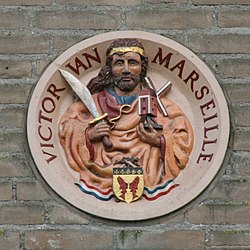Victor of Marseilles
Saint Victor of Marseilles | |
|---|---|
 | |
| Martyr | |
| Born | 3rd centuryAD |
| Died | c. 290 AD Marseille |
| Venerated in | Roman Catholic Church Eastern Orthodox Church |
| Feast | July 21 |
| Attributes | Depicted as a Roman soldier with a millstone; depicted overthrowing a statue of Jupiter; in stocks, comforted by angels; scourged and crushed by a millstone; or with his body beheaded and flung into the river, from which the angels take it;[1] depicted with windmill |
| Patronage | cabinetmakers, millers, torture victims, sick children; invoked against lightning |
Saint Victor of Marseilles was a Christian Martyr. He is venerated as a saint in the Roman Catholic Church and the Eastern Orthodox Church.
Life
Saint Victor is said to have been a Roman army officer in Marseille, who publicly denounced the worship of idols. For that, he was brought before the Roman prefects, Asterius and Eutychius, who later sent him to the Emperor Maximian.[2] He was then racked, beaten, dragged through the streets, and thrown into prison, where he converted three other Roman soldiers, Longinus, Alexander, and Felician, who were subsequently beheaded. After refusing to offer incense to the Roman god Jupiter, Victor kicked it over with his foot and was then crushed under a millstone.[2]
Veneration

In the 4th century, Saint John Cassian built a monastery over the site where the bodies had been buried in a cave, which later became a Benedictine Abbey and minor Basilica. This is St Victor's Abbey (Abbaye Saint-Victor).
Saint Victor's feast day, along with Sts Longinus, Alexander and Felician, is celebrated on July 21.
Patronage
Saint Victor is the patron saint of Tallinn, the capital of Estonia.[3] His life and martyrdom are celebrated in the scenes depicted in the High Altar of the St. Nicholas' Church, Tallinn.
